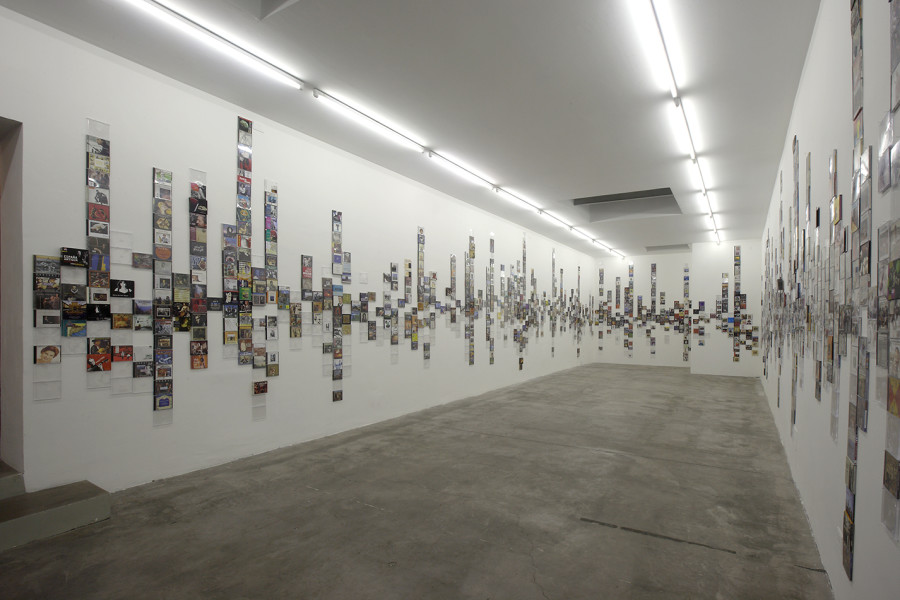Post
Ragamala
30 Novembre 2013 – 31 Gennaio 2014
Sabato 30 Novembre 2013 alle ore 16.00 Galleria S.A.L.E.S. è orgoliosa di inaugurare Ragamala quinta mostra personale di Stefano Arienti in galleria. Ragamala che letteralmente significa ghirlanda di raga è una parola presa a prestito dalla terminologia della musica classica indiana ed è anche il titolo dellautobiografia di Ravi Shankar, venuto a mancare nel 2012. Sintesi tra varie arti e multiculturalismo ispirano e divengono pretesto per Stefano Arienti per la creazione delle nuove opere che lartista ha realizzato appositamente per questo progetto da S.A.L.E.S. I nuovi lavori si inseriscono in modo armonico allinterno della pratica di Arienti, che negli ultimi anni ha trovato consolidamento attorno alla produzione di grandi opere installative, attraverso cui lartista modula il proprio dialogo con i luoghi istituzionali dellarte (Isabella Stewart Gardner Museum, Boston, Fondazione Bevilacqua La Masa, Venezia, 2012) in particolare il museo e con quei luoghi più legati alla cultura in senso lato, come il teatro (Teatro La Fenice Venezia, 2012) o la chiesa (realizzazione dellaltare per la Chiesa di San Giacomo Maggiore, Sedrina – BG). Ragamala è anche il titolo della grande installazione che Stefano Arienti ha realizzato nella sala centrale della galleria. Si tratta di un lavoro a parete composto da circa millecinquecento custodie di CD di album di musiche dal mondo oltre a diverse custodie di CD vergini, con cui lartista riempie gli spazi interstiziali dellinstallazione. Questo lavoro riprende lopera Custodie Vuote, presentata da Stefano Arienti alla Fondazione Bevilacqua La Masa di Venezia in occasione della sua mostra personale del 2012. Con Ragamala negli spazi di Galleria S.A.L.E.S. lartista amplia e ridefinisce lopera presentata a Venezia, sperimentando nuove modalità installative. Linstallazione accoglie il pubblico in un ambiente volutamente lasciato vuoto, riempito solo alle pareti, in cui gli spettatori si muovono come allinterno della navata affrescata di una chiesa. E in effetti Ragamala ricorda un affresco o un mosaico, sia per le caratteristiche tecniche, sia per le sua note di coralità, di universalità e il suo carattere quasi didattico unopera che è anche una raccolta, un archivio di saperi mobili alla pari di precedenti lavori in cui lartista esplora il luogo dellaBiblioteca. Nella project room della Galleria sono esposte alcune nuove opere della tipologia dei poster traforati. Questa tipologia di lavori, tipico nellambito della più vasta produzione dellartista, presenta in questa occasione la particolarità di essere tutti poster a carattere religioso, raffiguranti personaggi della tradizione devozionale devozione cattolica ed induista. Come scrive Arienti:Sia i CD che i manifesti sono materiali della cultura di massa che ora si stanno avviando ad un ruolo marginale, ma allo stesso tempo sono testimoni ancora diffusi delle culture del mondo Arienti, grande erede della tradizione concettuale italiana, esplora rapporto tra arte popolare e massificazione, senza uscire dai confini/dal quadro della pratica artistica ma riportando sempre questa ricerca sul piano di unelaborazione formale interna rispetto al fare creativo
On Saturday 3oth November 2013 at 4 pm Galleria S.A.L.E.S. is proud to inaugurate Ragamala, the fifth personal exhibition by Stefano Arienti at the Gallery. Ragamala, which letterally means garland of ragas, is a word taken from the terminology of classical Indian music and it is also the title of the autobiography of Ravi Shankar, who recently died in 2012. The synthesis among the arts and multiculturalism inspire the artist and are used as a pretext to create the new works realized expressly for this project at S.A.L.E.S. The new works integrate in un harmonical way with the previous practice of Arienti, which in the last years has found consolidation around the production of big installations, through which the artist modulates his dialogue with institutional art spaces museums in particular – (Isabella Stewart Gardner Museum, Boston, Fondazione Bevilacqua La Masa, Venice, 2012) and those places more tied to culture in a broad sense, like theatres (Teatro La Fenice Venice, 2012) or churches (realization of the altar for the Church of Chiesa di San Giacomo Maggiore, Sedrina – BG). Ragamala is also the title of the big installation that Stefano Arienti has realized in the central hall of the Gallery. It is a big wall work, composed by one thousand and five hundred CD cases of albums of music from all over the world and an undefined number of empty cases of virgin CDs, with witch the artist fill up the interstitial spaces of the installation.This work recalls the big piece Custodie Vuote (Empty Cases), presented by Stefano Arienti at the Fondazione Bevilacqua La Masa in Venice on the occasion of his personal exhibition in 2012. With Ragamala, in the space of Galleria S.A.L.E.S. the artist expands and redefines the work presented in Venice, experimenting new installation modalities. The installation embraces the audience in an environment intentionally left empty, where (only) the walls are covered up by (the CD cases) and where the viewers move as if they were inside the nave of a church decoreated with frescos or mosaics. Ragamala reminds a fresco or a mosaic, for its technical qualities, for its choral notes and for its nearly didactic character. A work that is also a collection, an archive of mobile knowledges, like Arienti has already done before when he explored the place of the Library. In the project room of the Gallery are exhibited new works of the typology of the drilled posters. This particular type of works, tipical among the vastest production of the artist, presents in this occasion the peculiarity that the they are all posters of religous theme, depicting characters of the Catholic and Hinduist devotional tradition. As Arienti writes: Both CDs and posters are materials of the mass culture that are destined to cover a marginal role, but that at the same time are still widespread witnesses of world cultures. Arienti, a prominent heir of Italian conceptual tradition, explores the relationship between popular art and massification, without overstepping the borders of artistic practice, always carrying his research on the terrain of formal elaboration, that is internal with respect to the making of art.
